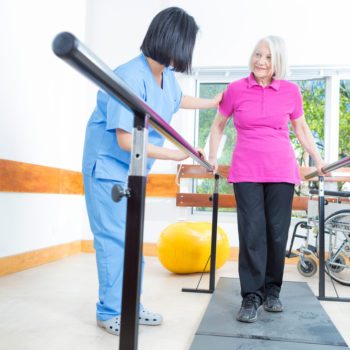Why We Love It
-
$81,690Potential Avg. Salary
-
26.6%Job Growth Rate
-
Growing DemandJob Outlook
-
Flexible HoursCareer Attribute
This is a specialist that helps patients with physical disabilities such as the blind, disabled people and the visually impaired to stay put and perform various activities in the community. This reduces the level of dependability of these individuals to their family members as they are taught how to use various devices that can support them. Through their aid, these people feel more comfortable and they can therefore get involved in the community projects, sports and games among many others. These professionals also serve as an intermediate between patients and financial institutions and legal advisors.
Recommended Schools
What is an Orientation & Mobility Specialist?
Duties
The duties that are performed by an orientation and mobility specialist entail the following;
- Take part in the referral of those patients with physical and visual disabilities.
- Engage the patients in discussion to determine their needs and help them accordingly.
- They orient the patients with disabilities to adapt to the environment.
- Educate the patients on how to use various devices and how to keep personal safety.
Day in the life
Orientation and mobility specialist work by getting in direct contact with the patients or by doing other services that still indirectly benefits them. For instance, they advise the patients and support them over their problems, educate them and spend some of the time in the office checking through their files and also by communicating with other professionals for further assistance.
Apart from these duties, the specialists also travel to visit the patients where they engage them in their discussions and help them solve their issues accordingly. They for instance, interview them and come up with solutions based on what the patient says. They also check the family of the patient to make sure there are appropriate conditions for the patient to stay without complaining.
This does not therefore mean that the job is quite easy. At times, it might be very stressful that some of the patients may become uncooperative and therefore, hindering the Orientation and mobility specialist from collecting the right data. This can be very stressful especially when one is alone with the patients.
Work schedule
Orientation and mobility specialists can either work on a part time or a full time basis by providing consultative and direct services to those with disabilities. They do work for 40 hours in a week. Extra hours may be involved and this may require extending the working hours to.
Growth of the job
With regards to the U.S Bureau of Labour Statistics, it is projected that the employment status of Orientation and mobility specialists working with the disabled people is expected to go up faster than the average between 2014 and 2024. The professionals will continue to provide their support to the patients and their families and educate them public to avoid stigmatizing the patients. In this regard, more facilities that give aid to the patients with both physical and visual disabilities will be constructed in large numbers and this will therefore be the reason for the increased job opportunities.
Typical employer
Employment opportunities for an orientation and mobility specialist are available for public programs, profit and non-profit organizations. Once you have trained and met all the requirements, you can get employed in a hospital, where you can help patients with disabilities. By working in a retail pharmacy, you can get in direct touch with the patients who may visit the place to buy various things such as canes and wheelchairs. Other people work at the social service agencies where they get paid by helping those with disabilities.
Recommended Schools
How To Become an Orientation & Mobility Specialist
In order to become a certified Orientation and mobility specialist, there is an exam that needs to be done after the coursework and the internship programs are complete. These exams are offered by certified AER institutions that are found in most states of the country.
Preparation for the job requires completing a certification program as the least requirement. This is offered by many community based colleges after which one sits for ACVREP test. Once you have completed this, you do not necessarily require a degree for certification. Other people may become certified through completing an undergraduate course in Orientation and Mobility and even a Master’s program.
Completing a degree related to visual impairment is also an alternative to becoming an O & M specialist. Most degrees and Master’s programs take at least 12 months or simply a trimester. Some programs are taught continuously while others are summer-based for those who may have other jobs. The internship program on the other hand, takes several months after completing a degree or certificate program.
Orientation & Mobility Specialist Salary Data
We’ve provided you the following to learn more about this career. The salary and growth data on this page comes from recently published Bureau of Labor Statistics data while the recommendations and editorial content are based on our research.
National Anual Salary
Low Range
$66,040Average
$81,690High Range
$116,030National Hourly Wage
Low Range
$32/hrAverage
$39/hrHigh Range
$56/hrHow do Orientation & Mobility Specialist salaries stack up to other jobs across the country? Based on the latest jobs data nationwide, Orientation & Mobility Specialist's can make an average annual salary of $81,690, or $39 per hour. On the lower end, they can make $66,040 or $32 per hour, perhaps when just starting out or based on the state you live in.
Salary Rankings And Facts
#133 Nationally for All Careers
Above Average Salary Nationally
Programs and Degrees
Here are the most common degrees for becoming an Orientation & Mobility Specialist. a is usually recommended and specifically a degree or coursework that prepares you for the particular field, see below.
Highest Education Among Orientation & Mobility Specialists
- 4.6% Doctorate
- 41.7% Masters
- 43.5% Bachelors
- 8% Associates
- 1.4% College
- 0.4% High School
- 0.3% Less than High School
Job Growth Projections and Forecast
2014 Total Jobs
114,6002024 Est. Jobs
145,100Job Growth Rate
26.6%Est. New Jobs
30,500How does Orientation & Mobility Specialist job growth stack up to other jobs across the country? By 2024, there will be a change of 30,500 jobs for a total of 145,100 people employed in the career nationwide. This is a 26.6% change in growth over the next ten years, giving the career a growth rate nationwide of Above Average.
Growth Rankings And Facts
#21 Nationally for All Careers
Above Avg. Growth Nationally
What Companies Employ The Most Orientation & Mobility Specialists
| Industry | Current Jobs | New Jobs Needed | % Increase |
|---|---|---|---|
| Offices of physical, occupational and speech therapists, and audiologists | 27,600 | 13,800 | 14% |
| General medical and surgical hospitals; private | 21,500 | 1,500 | 2% |
| Elementary and secondary schools; local | 12,300 | 2,000 | 2% |












